Natural Resources and the Environment 2002
Greenhouse gas emissions have never been higher
Published:
The Norwegian emissions of greenhouse gases increased by 2 per cent from 2000 to 2001, and have now reached the highest level ever recorded. The amounts of waste continue to increase, and each Norwegian generates close to 2 tonnes of waste every year. The discharges to water from the petroleum activities have increased significantly since the mid 1990's, but last year's change was modest. The pressure on the Norwegian nature from acidifying substances is decreasing. The discharges of the plant nutrients phosphorus and nitrogen to sensitive coastal areas have been reduced, but the nitrogen inputs still have to be reduced substantially to reach the reduction target.
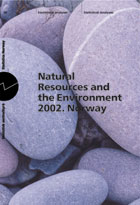
|
Higher greenhouse gas emissions
If the emissions of the so-called greenhouse gases continue to increase, we risk extensive and damaging climate change in the course of the next 100 years. A complete reorganization of the world's energy consumption pattern seems to be necessary to solve the problem, since the emissions from energy use is by far the largest source of these types of gases. The countries of the world are trying to organize emission reductions within the framework of the Kyoto Protocol.
Norwegian greenhouse gas emissions rose by more than 8 per cent from 1990 - the baseline year of the Kyoto Protocol - to 2001, and are now at the highest level ever. The increase last year was 2 per cent. CO 2 accounted for three quarters of Norways aggregate greenhouse gas emissions in 2001.The most important emission sources are road traffic, oil and gas extraction, combustion in manufacturing industries and process emissions in metal production.
According to the Kyoto Protocol, the Norwegian emissions - when the so-called Kyoto mechanisms are taken into account - may only increase by 1 per cent between 1990 and the period 2008-2012.
Still low imports of ozone depleting substances
Emissions of gases containing chlorine and bromine, such as CFCs, HCFCs and halons, deplete the atmospheric ozone layer, which protects the earth against harmful UV radiation from the sun.
Imports of ozone depleting substances have been very low in recent years. The consumption of such substances in Norway has been reduced by 98 per cent since 1986 (measured by ozone depleting potential). Nevertheless, emissions are still being generated in connection with the use and replacement of old products. These emissions will be reduced as old products are phased out. Norway has fulfilled the requirements concerning the reduction in use and phasing out of ozone depleting substances both under the Montreal Protocol and under the new EU directive that entered into force in September 2000.
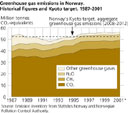
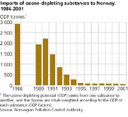
International agreements have effects
The international agreements on reductions in emissions of long-range air pollutants causing acidification are also showing results. The deposition of acidifying substances in Norway has been substantially reduced during the last decade. The areas in Norway where nature's critical load for acidification are exceeded have been reduced by more than 30 per cent since 1985. Emissions from other European countries account for about 90 per cent of acid deposition in Norway.
Acid rain - caused by emissions of sulphur and nitrogen containing compounds - is still one of the most serious environmental problems in Norway, even though reductions in emissions have reduced the extent of acidification. The southern parts of Norway are particularly affected by acid rain, but some of the eastern parts of the county of Finnmark are also affected. The total combined Norwegian emissions of acidifying gases have not been significantly reduced, and the authorities' target for 2010 has not yet been reached.
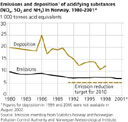
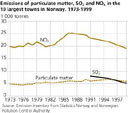
No improvement in air pollution in towns?
Clean air is important for health and quality of life. At times, local air pollution gives significant health and welfare problems in the largest towns and urban settlements in Norway. In the largest towns a substantial proportion of the population is exposed to concentrations of air pollutants that increase the risk of premature death and health problems, such as respiratory infections, lung disease and cancer. The socio-economic costs of health damage caused by air pollution have been estimated by Statistics Norway to be several billions NOK per year.
There has been a certain decrease in the emissions of nitrogen oxides and sulphur dioxide in the largest towns in the last 10 years, but the emissions of particulate matter is at about the same level as 10 years ago. However, new revised figures show that the emission level of particulate matter is about twice as high as previously calculated. The most important sources of local air pollution today are road traffic and heating in private households (fuelwood use). Fuelwood use actually constitutes 84 per cent of total particulate matter emissions. Fuelwood use is also an important emission source for heavy metals, PAH (polycyclic aromatic hydrocarbons) and dioxins.
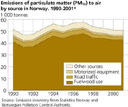
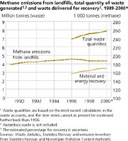
Amounts of waste are still increasing
Waste gives rise to environmental problems because waste treatment and disposal generate emissions of pollutants. Landfilling of waste generates emissions of methane, which is a greenhouse gas. Landfills - particularly the older ones - also contain various kinds of POPs and heavy metals and other substances that can pollute air, water and soil if they are released into the environment. Incineration is a method of waste treatment that eliminates methane emissions and other problems associated with landfilling, but generates emissions of various pollutants to air and produces ash that must be treated as hazardous waste. New incineration technology has made it possible to reduce such emissions considerably.
The total annual waste amount has increased by about 13 per cent from 1996 to 2000. A total of 8.5 million tonnes of waste - about 2 tonnes per capita - was generated in 2000. The amounts for material recovery and incineration with energy recovery have increased by 22 per cent, and constituted 44 per cent of the total amount of waste in 2000. The authorities' target is a total recovery share (material recovery and incineration with energy recovery) of 75 per cent.

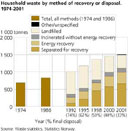
The amount of household waste per capita was 335 kg in 2001. This is 100 kg more than in 1992, and almost twice as much as in 1974. Household waste - 1.5 million tonnes in 2001 - constitutes just below one fifth of the total annual waste amount in Norway.
Of a total amount of 631 000 tonnes of hazardous waste, 581 000 tonnes was dealt with through the proper channels in 1999. Nearly 10 per cent of the total amount - about 50 000 tonnes - was in other words dealt with outside proper channels, and significant amounts of this may be inappropriately dumped.
Discharges from petroleum activities have increased significantly
Discharges of oil and chemicals from shipping, the offshore petroleum industry and onshore activities can damage organisms and ecosystems in the open sea, on the sea floor, in the littoral zone and on land. Pollution of coastal areas also reduces their value as recreation areas and for other purposes.
Oil production results in both uncontrolled (acute) discharges and legal, licensed (operational) discharges. Operational discharges are the largest category, and have risen considerably in the 1990s, and relatively faster than the oil production. Acute discharges from oil production and other activities vary widely, but there has been an overall decrease in recent years. The total discharges have not changed much the last year.
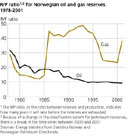
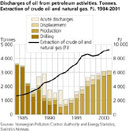
Oil and gas resources - economically important but of limited duration
As of 1 January 2002 the remaining Norwegian reserves of oil and gas corresponded to about 1 per cent of the world's total reserves (the reserves include only the recoverable part of total resources). Norway's crude oil and natural gas production corresponded to 4.5 and 2.3 per cent of the world production, respectively. The remaining Norwegian reserves of oil and gas will be exhausted (as expressed by the ratio between reserves and production; the R/P ratio) after 9 and 38 years, respectively. The world's R/P ratio for oil as of 1 January 2002 is estimated at 40.3, and for gas 61.9.
The reserve estimates are subject to constant, sometimes large, re-evaluations, and decisions to develop new fields are made almost each year. The total petroleum resources are considerably larger. These are defined as an estimate of all more or less definitely proven deposits.
Hydropower - a renewable resource
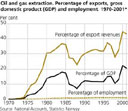
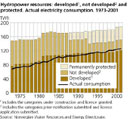
In contrast to the petroleum resources, the hydropower resources are renewable. Norway has Europe's largest hydropower resources, and hydropower was an important basis for the industrialization of the country. The rich supplies of hydropower have a great influence on the energy mix. Almost 100 per cent of the electricity use is based on hydropower, and in year 2000 electricity accounted for 42 per cent of total energy consumption in Norway; the highest proportion in the world.
The size of the hydropower potential is evaluated on a continuous basis, and is dependent on technological and economic conditions as well as changes in the climatic regime. Consequently, the size of the estimated hydropower potential may change from year to year. In the last decades the consumption has increased more than the supply, and is now higher than the production in a year with normal precipitation.
About 36 per cent of the hydropower potential has not been developed, and rather more than half of this is permanently protected.
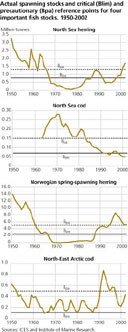

Fish resources - need for a cautious exploitation
In the Annual report on marine resources 2002 the Institute of Marine Research points out that it is still necessary to exercise caution in the exploitation of several of our important fish stocks. This is particularly the case for demersal fish stocks; the pelagic stocks are generally in a better state. The North Sea cod stock is at a particularly low level. This stock has been, and is still, very heavily exploited.
The stock of North Sea herring is growing, and the spawning stock is currently above the precautionary spawning stock level. The North Sea cod stock is - as mentioned above - in a poor condition, and the spawning stock is far outside safe biological limits. The spawning stock of Norwegian spring-spawning herring has decreased somewhat during the last years, but the stock is considered to be within safe biological limits. The spawning stock of North-east Arctic cod has had a small increase last year, but is still below the precautionary spawning stock level. However, this appears to have been the case for most of the period after 1950.
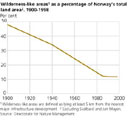
Biodiversity - little left of wilderness areas
Biodiversity is affected and threatened by human activities in a number of ways, and calculations show alarmingly high figures for losses of both species and habitats. Such losses may be a direct result of various forms of development and over-exploitation. Biodiversity is also affected by pollution effects such as climate change and acidification.
The extent of untouched or wilderness-like areas is an indicator of the pressure on the biological diversity. In such areas, pressure from human activity is low, and there is little disturbance of the original biological diversity. The proportion of wilderness-like areas in Norway fell dramatically from 1900 to 1985, especially in the period 1940-1985. Since 1985, the loss of wilderness-like areas has continued, but at a much slower pace. However, the remaining areas are small; totalling 12 per cent of Norways land area.
Contact
-
Statistics Norway's Information Centre
